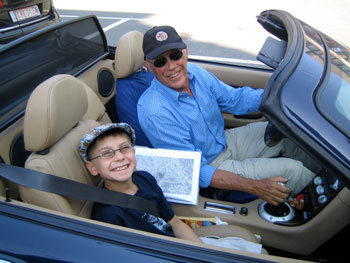 We drove over 5,000 km through 5 European countries in our rental car – an Opel Astra – on our recent family holiday. The car worked very well, though it was hardly the performance vehicle that my husband was craving (he nicknamed it the ‘gutless wonder’), especially for the German Autobahn.
We drove over 5,000 km through 5 European countries in our rental car – an Opel Astra – on our recent family holiday. The car worked very well, though it was hardly the performance vehicle that my husband was craving (he nicknamed it the ‘gutless wonder’), especially for the German Autobahn.
Driving in Europe has some unique advantages over driving here at home in North America. Not the least of which in my view, is the fact that there are rules of the road that people actually follow.
Here are some observations about driving in Europe.
1. No Passing on the Right
This is completely verboten in every country we visited, and the police will nail you with a serious ticket if you get caught speeding past another car in the right lane of the highway. The passing lane is the left lane, and as soon as you are done passing someone in that lane, you move to the middle or right lane immediately, or risk getting rear-ended (or worse) by that Ferrari or Mercedes whipping past you at 200 km (or more) an hour. Even when you may be going 160 km an hour!
Nobody ‘sits’ in the left lane biding their time as they creep by to pass someone. Nor do they pass moral judgment on other drivers who are going faster than them, by sitting in the passing lane clogging up the roads. If only this tradition could be grafted onto our driving culture in North America!
I find that this system is safer in that you do not need to be worried about people passing you on both sides of the highway, which is the way of the world in the New World, and a recipe for road chaos and traffic disorder.
2. No Speed Limits
Now, the speeding issue is something else entirely. While many countries (Switzerland, Austria) have strict speed limits that are heavily enforced, others appear to allow more latitude. Germany is the most open, though Italy seemed absent of any traffic enforcement during our travels, even in construction zones.
If you love to drive and have a car that can match your desires, Germany is the driver’s utopia. While many roads and highways do have speed limits, when you are on the Autobahn and see 130 posted with a slash through it, move to the right lane and watch the drivers max out their high-end vehicles. Some of the speeds traveled are astonishing and not just a little frightening. The downside of no speed limits is of course that when car accidents happen, they are catastrophic and deadly. I don’t know if the risks are worth it, but then I don’t dream of being a racecar driver either.
3. No Right Turn on Red
Safer for pedestrians by far, and other drivers as well who don’t have to worry about a car sticking half-way into the intersection trying to turn on a red light. Many of our accidents in Vancouver over recent years have been caused by this practice, and while it is convenient for drivers, one wonders how much time is really saved on a journey by allowing right turns on red lights.
4. Priority of the Right – Belgium
Belgium has very aggressive drivers. Not only do drivers not facilitate new cars merging on highways by changing lanes (cars merging have to wrestle their way onto the highway), the priority of the right at intersections signifies that cars coming from that direction have priority over you, and will burst past you at high speeds with nary a glance in your direction.
You are responsible for ensuring that nobody is coming from the right (if the intersection is unmarked by yields or stop signs), hence the common sight of traffic mirrors to assist you in ensuring you are not t-boned in downtown Brussels. A comfortable drive in the city or country, this system does not make.
5. Cars and Bikes – Live and Let Live
On many city and country roads in the countries we visited, cars, motorcycles, and bicycles co-exist in harmony. While we give lip service to ‘sharing the road’ in Vancouver, it is in Europe where this practice is truly honoured and respected. Part of the reason may be the maturity of the biking culture, which is strong and vibrant and well-respected. Commuters and students biking to work and school have priority. Bike lanes are separated from car lanes, or marked by coloured paving. Racing cyclists aren’t honked or yelled at when being passed by cars. It all seemed much more civilized and free of the anxiety and stress I experience when I bike on the ‘shared’ bike lanes of Vancouver.
Travellingmom tip:
Research and pre-book your rental car (we used Europcar) from home before you leave on holiday. You will have a good choice of cars, be able to compare prices and find better deals than by booking at the airport upon your arrival. Also, booking a diesel vehicle will save you money on fuel costs, especially if you plan a lot of driving. Even diesel fuel, the cheapest fuel available in Europe, is more than double the price of our lowest-grade regular fuel in North America.